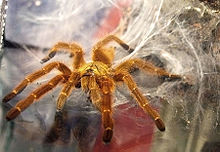Harpactirinae
| Harpactirinae | |
|---|---|

| |
| A Pterinochilus murinus tarantula | |
| Scientific classification | |
| Kingdom: | Animalia |
| Phylum: | Arthropoda |
| Subphylum: | Chelicerata |
| Class: | Arachnida |
| Order: | Araneae |
| Infraorder: | Mygalomorphae |
| Family: | Theraphosidae |
| Subfamily: | Harpactirinae Pocock, 1897 |
| Genera | |
|
See text | |
The Harpactirinae (commonly called baboon spiders) are a subfamily of tarantulas which are native to the continent of Africa. Like many Old World tarantulas, they have a relatively strong venom, and can inflict a painful bite.
Description[]
Harpactirinae are ground-dwelling spiders which build silk-lined burrows, often under debris such as stones, using their fangs and chelicerae for digging. Habitats include savanna woodlands, grasslands, and dry scrublands.[citation needed]
Systematics[]
The following genera and species are present in the Harpactirinae. In addition, the genus Brachionopus (Pocock, 1897) has been suggested for placement in this subfamily, but its taxonomy is currently disputed.
Augacephalus (Gallon, 2002)
Type species: Augacephalus breyeri
In synonymy:
(Schmidt, 1995) =
- Augacephalus breyeri (Hewitt, 1919) — Mozambique, South Africa, Swaziland
- (Gallon, 2001) — Mozambique, the Mozambique Gold[en] Baboon, Mozambique Half Moon Baboon
- (Simon, 1904) — East, South Africa, the [East African] Bushveld Golden Brown Featherleg Baboon
Bacillochilus (Gallon, 2010) [monotypic]
- Bacillochilus xenostridulans (Gallon, 2010) — Angola
Brachionopus (Pocock, 1897)
To quote Platnick's World Spider Catalog v. 12.5,[1] "N.B.: transferred here from the Barychelidae by Raven, 1985a: 112; Brachyonopus is an unjustified emendation; Raven's transfer was not accepted by Charpentier, 1993: 5 or Schmidt, 2002a: 12 and 2008: 3, who nevertheless identified no close relatives of the genus among the known barychelids; Gallon, 2002: 204 argued for its inclusion in the Barychelidae but indicated that it "does not fit in any current barychelid subfamily" but later (Gallon, 2010b: 79) considered it a harpactirine.".
In other words, its taxonomy is in dispute and the many recent workers do not consider it a theraphosid. All are found in South Africa.
- (Purcell, 1903)
- (Strand, 1907)
- (Purcell, 1904)
- Brachionopus robustus (Pocock, 1897)
- (Purcell, 1903)
Ceratogyrus (Pocock, 1897) [Senior synonym of Coelogenium Purcell, 1902]
Type species: Ceratogyrus darlingi
Transferred to other genera:
→
→
(Smith, 1990) → Pterinochilus chordatus
In synonymy:
Ceratogyrus bechuanicus (Purcell, 1902) and (Purcell, 1908) = Ceratogyrus darlingi
(De Wet & Dippenaar-Schoeman, 1991) = Ceratogyrus marshalli
- Ceratogyrus brachycephalus (Hewitt, 1919) — Botswana, Zimbabwe, South Africa, the [Botswanan] Greater Horned Baboon
- Ceratogyrus darlingi (Pocock, 1897) — Zimbabwe, Mozambique, the [Zimbabwean, African] Rear Horned Baboon, Curved Horn Baboon
- Ceratogyrus dolichocephalus (Hewitt, 1919) — Zimbabwe
- (Smith, 1990) — Malawi
- Ceratogyrus marshalli (Pocock, 1897) — Zimbabwe, Mozambique, the [Zimbabwean] Straight Horned Baboon
- Ceratogyrus meridionalis (Hirst, 1907) — Malawi, Mozambique, the [Malawian], Zimbabwe{an} Gray Baboon
- (Gallon, 2005) — Republic of South Africa
- (Purcell, 1902) — Zimbabwe, Mozambique
- (Strand, 1906) — Namibia, Zimbabwe, the [Namibian] Sandy Horned Baboon
Eucratoscelus (Pocock, 1898)
Type species: Eucratoscelus constrictus
Transferred to other genera:
(Schmidt & Gelling, 2000) →
In synonymy:
(Pocock, 1898) and = Eucratoscelus constrictus
- Eucratoscelus constrictus (Gerstäcker, 1873) — Kenya, Tanzania
- (Schmidt & Von Wirth, 1990) — Tanzania
Harpactira (Ausserer, 1871)
Type species:
- (Latreille, 1832) — South Africa
- (Purcell, 1903) — South Africa
- (Walckenaer, 1837) — South Africa
- (Pocock, 1897) — South Africa
- (Pocock, 1898) — South Africa
- (Pocock, 1897) — South Africa
- (Purcell, 1902) — South Africa
- Harpactira gigas (Pocock, 1898) — South Africa
- (Strand, 1907) — South Africa
- (Pocock, 1902) — South Africa
- (Pocock, 1897) — South Africa
- (Simon, 1892) — South Africa
- (Purcell, 1902) — South Africa
- (Purcell, 1902) — Namibia, South Africa
- Harpactira pulchripes (Pocock, 1901) — South Africa, the [South African] Golden Blue Leg{ged} Baboon, Slate Gray Leg(ged) Baboon
- (Ausserer, 1875) — South Africa
Harpactirella (Purcell, 1902) [Senior synonym of Luphocemus {Denis, 1960}]
Type species:
Transferred to other genera:
(Lawrence, 1936) →
(Strand, 1908) →
(Benoit, 1965) →
- (Purcell, 1903) — South Africa
- (Purcell, 1903) — South Africa
- (Denis, 1960) — Morocco (Dubious)
- (Purcell, 1902) — South Africa
- (Purcell, 1908) — South Africa
- (Purcell, 1902) — South Africa
- (Purcell, 1902) — South Africa
- (Purcell, 1903) — South Africa
- (Gallon, 2010) — South Africa
- (Purcell, 1904) — South Africa
- (Purcell, 1908) — South Africa
- (Purcell, 1902) — South Africa
Idiothele (Hewitt, 1919)
Type species:
In synonymy:
(Purcell, 1902) and (Benoit, 1965) =
- Idiothele mira (Gallon, 2010) - South Africa, the South African Blue Footed Trapdoor Baboon
- (Pocock, 1898) — Southern Africa
Pterinochilus (Pocock, 1897) [Senior synonym of Pterinochilides {Strand, 1920}]
Type species:
Transferred to other genera:
→ Augacephalus breyeri
and → Eucratoscelus constrictus
and →
and →
→ Ceratogyrus meridionalis
→ Trichognathella schoenlandi
In synonymy:
(Tullgren, 1910), (Caporiacco, 1940), (Strand, 1917), (Strand, 1906), (Smith, 1990), (Tullgren, 1910), and (Strand, 1906) = Pterinochilus chordatus
(Lawrence, 1936), (Hewitt, 1919), and =
Pterinochilus hindei (Hirst, 1907), (Schmidt, 2002), and Pterinochilus mamillatus (Strand, 1906) = Pterinochilus murinus
(Strand, 1920), (Strand, 1920), and (Strand, 1920) =
- (Berland, 1914) — Kenya
- (Gallon, 2009) — Northwestern Kenya
- Pterinochilus chordatus (Gerstäcker, 1873) — East Africa, the Kilimanjaro Mustard Baboon
- (Gallon, 2008) — Angola
- (Gallon & Engelbrecht, 2011) — Waterberg mountains of Limpopo Province, South Africa
- (Pocock, 1900) — Eastern and Southern Africa, the Dodoma Fort Hall Baboon
- Pterinochilus murinus (Pocock, 1897) — Angola, Central, Eastern, Southern Africa, the Usumbara Orange Baboon, Mombasa Golden Starburst [Baboon], "OBT"
- (Gallon, 2009) — Southcentral Kenya
- (Berland, 1917) — Angola, Congo
- (Pocock, 1897) — Angola, Central, East Africa
Trichognathella (Gallon, 2004) [Monotypic?]
- Trichognathella schoenlandi (Pocock, 1900) — South Africa
References[]
- ^ Platnick, Norman I. "World Spider Catalog", "American Museum of Natural History."
External links[]
- Theraphosidae
- Spiders of Africa
- Spider subfamilies